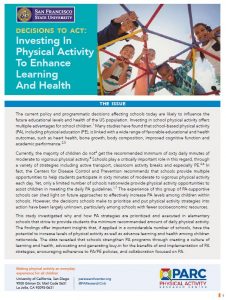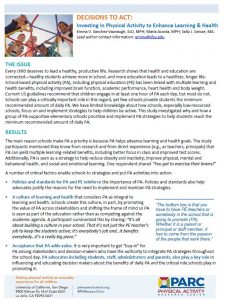Decisions to Act: Investing in Physical Activity to Enhance Learning and Health
By: Emma V. Sanchez-Vaznaugh, Maria Acosta, and Sally J. Geisse, San Francisco State University
 Every child deserves to lead a healthy, productive life. Research shows that health and education are connected—healthy students achieve more in school, and more education leads to a healthier, longer life. School-based physical activity (PA), including physical education (PE) has been linked with multiple learning and health benefits, including improved brain function, academic performance, heart health and body weight. Current US guidelines recommend that children engage in at least one hour of PA each day, but most do not. Schools can play a critically important role in this regard, yet few schools provide students the minimum recommended amount of daily PA. We have limited knowledge about how schools, especially low-resourced schools, focus on and implement strategies to help children be active.
Every child deserves to lead a healthy, productive life. Research shows that health and education are connected—healthy students achieve more in school, and more education leads to a healthier, longer life. School-based physical activity (PA), including physical education (PE) has been linked with multiple learning and health benefits, including improved brain function, academic performance, heart health and body weight. Current US guidelines recommend that children engage in at least one hour of PA each day, but most do not. Schools can play a critically important role in this regard, yet few schools provide students the minimum recommended amount of daily PA. We have limited knowledge about how schools, especially low-resourced schools, focus on and implement strategies to help children be active.
This study investigated why and how a group of PA-supportive elementary schools prioritize and implement PA strategies to help students reach the minimum recommended amount of daily PA.
Results
 The main reason schools make PA a priority is because PA helps advance learning and health goals. The study participants mentioned they know from research and from direct experience (e.g., as teachers, principals) that PA can yield multiple learning-related benefits, including better focus in class and improved test scores. Additionally, PA is seen as a strategy to help reduce obesity and inactivity, improve physical, mental and behavioral health, and social and emotional learning. One respondent shared “You got to exercise their brains!”
The main reason schools make PA a priority is because PA helps advance learning and health goals. The study participants mentioned they know from research and from direct experience (e.g., as teachers, principals) that PA can yield multiple learning-related benefits, including better focus in class and improved test scores. Additionally, PA is seen as a strategy to help reduce obesity and inactivity, improve physical, mental and behavioral health, and social and emotional learning. One respondent shared “You got to exercise their brains!”
A number of critical factors enable schools to strategize and put PA activities into action.
- Policies and standards for PA and PE reinforce the importance of PA.
- A culture of learning and health that considers PA as integral to learning and health.
- Acceptance that PA adds value.
- Funding and resources often drive decisions to put PA strategies in practice.
Recommendations
The results offer critical insights for policy and decision-makers to increase PA and PE in schools across the nation.
- Policymakers can strengthen policies regarding PA/PE by including requirements for funding allocations, guidelines for implementation and compliance measures.
- Everyone, including policymakers, advocates, schools and school districts, should create and foster a culture of learning and health that embraces the multiple benefits of PA.
- Funding agencies can offer grants and technical assistance to support grant writing for low-resourced schools.
- Schools and school districts can foster collaboration and networking. This includes ensuring that time and resources are available, such as professional development opportunities and conferences related to PA, for staff and community members to share ideas and use resources effectively.
Download the Report
A 14-page full report (PDF) and 2-page lay summary (PDF) are available.
